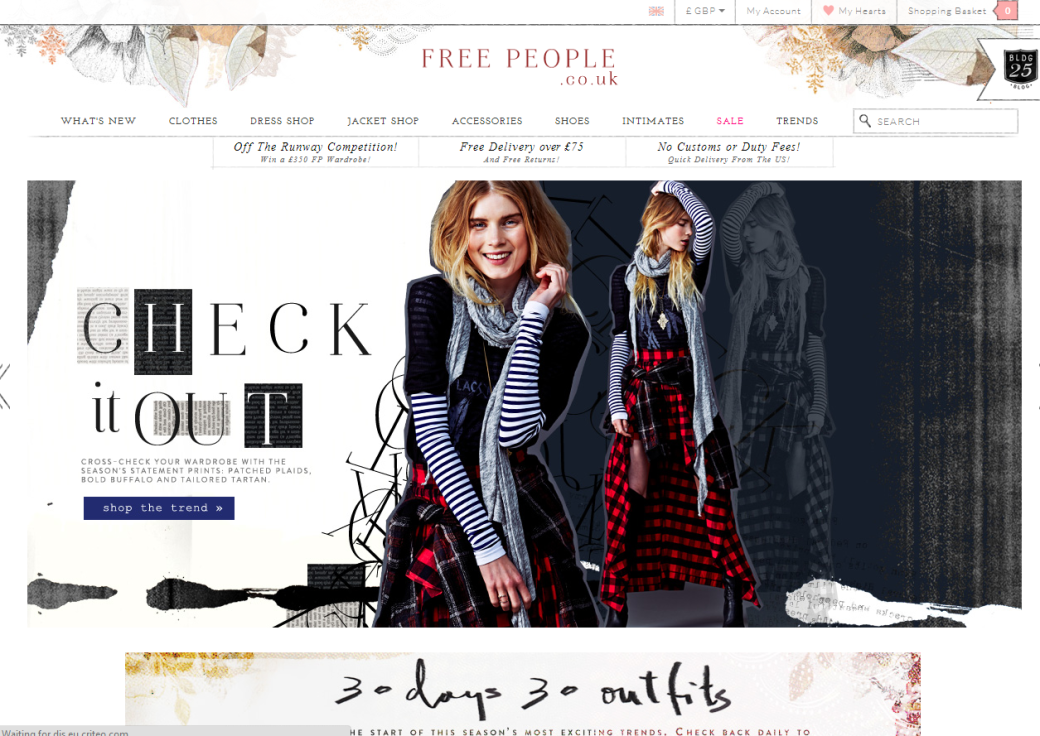Suppliers and Distribution Channels
Urban Outfitters delivers a distinctive, recognizable shopping concept, whether a customer visits a brick-and-mortar store, goes online to the Web site, or makes selections through its mail-order catalogs.
The majority of stores are in upscale metropolitan areas. Keeping in mind the demographics of its consumer and for convenience Urban Outfitters also have online store services and catalogue services. They have also introduced a new warehouse management project which can enhance their distribution process. The pack-and-ship system helps the multi-channel retailer more efficiently organize and forward products to stores.

Free People website
An article on
Inboundlogistics.com discusses how the company attributes its strong sales in part to a lean buying strategy that creates a sense of urgency among its customers. While many retailers plan to sell a significant percentage of their merchandise as markdowns, such thinking only encourages shoppers to wait eight weeks so they can buy at a lower price.”At the Urban and Anthropologie stores, and Free People site, if customers don’t buy it when they see it, odds are they will lose their chance, because the sizes will be broken or the item will be sold out,” John Kyees told analysts at a William Blair & Company growth stock conference.”We love selling out of items because that creates a sense of urgency,” he added.Urban Outfitters’ ability to ship lean, while remaining confident it can restock shelves and keep up with rapid growth in both stores and sales, springs from an idea called “concept to market”.”Given the company’s growth plans, which we were well aware of, it was essential to have a complementary supply chain strategy in place,” McKinney says. Most importantly, the strategy required the company to design flexibility into its scheduling process. It accomplished that by putting dual sourcing strategies in place.”We developed fabric and raw materials sources in alternate locations,” Rozsas explains. “Doing that greatly compresses our turnaround time in case of a reorder. “We manufacture an initial order in one location and the reorder in another,” she adds. “The ability to dual source lets us deliver less quantity up front. In effect, our calendar flexibility enables us to optimize inventory.” Every two weeks, Urban Outfitters’ supply chain team sits down with the company’s other key executives to touch base, assess the fluidity of a process that includes more than 1,500 vendors, and discuss needed changes or adaptations. In the case of concept-to-market, the goal is to reduce the time from designer concept to store shelf from 18 weeks down to nine or 10.

Urban Outfitters, Inc., West Coast Internet Fulfillment Center in Reno, Nev.
Urban Outfitters also refined its technology process. In 2008 the company launched a new wholesale information management system in both its Pennsylvania and Nevada distribution centers. “The beauty of the system is that it allows me to choose from a menu of daily reports to assess our overall supply chain and distribution operations and determine what, if any, situations we need to address,” McKinney says. “For instance, our direct-to-consumer channel is time sensitive,” he notes. “We like to ship within 24 hours, or even faster if it’s an expedited order, and now I can get a daily report that tells me if we succeeded.” Other reports detail shipments by state, by weight, and by carrier. “It’s a lot of helpful information that enhances how we manage the supply chain,” he says.
Urban Outfitters also implemented a merchandise lifecycle management suite from TradeStone Software Inc., a private-labels solutions provider based in Gloucester, Mass., across all its brands. To support the company’s sales growth, TradeStone’s technology provides full end-to-end supply chain visibility from design to delivery. “Our selection of TradeStone’s technology is yet another example of how much due diligence goes into every decision we make,” McKinney says. “We looked at a number of systems over 18 months, and while some systems were stronger in areas I cared about and others were stronger in areas Barbara Rozsas cared about, this was the one system that had most of what we both wanted.”TradeStone’s system places many different attributes at decision-makers fingertips, McKinney says. “We like the software’s ability to provide us with product visibility at each point in the lifecycle,” he says. “The system enables us to more effectively manage exceptions and respond to changing consumer demand.”

